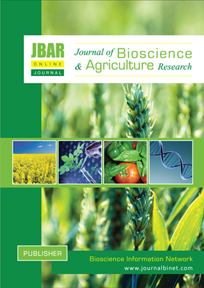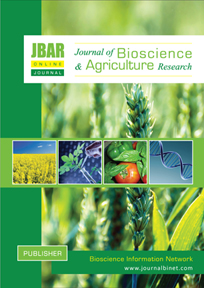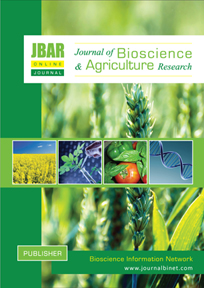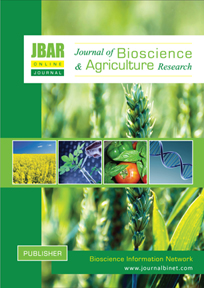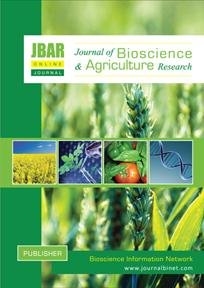Journal of Bioscience and Agriculture Research
Volume 31 - Issue 01 | Year of Publication: 2023
Article Type: Research Article | No. 311, 2023 | Country: Bangladesh | pp. 2581-2588 | Open Access
Title: Mung bean (Vigna radiata L.) growth response to prilled and super granule urea application
Authors: Haque, M. M., Islam, M. A., Amin, A. K. M. R. and Karim, M. F.
DOI: https://doi.org/10.18801/jbar.310123.311
Title: Mung bean (Vigna radiata L.) growth response to prilled and super granule urea application
Authors: Haque, M. M., Islam, M. A., Amin, A. K. M. R. and Karim, M. F.
DOI: https://doi.org/10.18801/jbar.310123.311
Mung bean (Vigna radiata L.) growth response to prilled and super granule urea application
Abstract
Breeders rely on the genetic variability among advanced breeding lines derived from diverse parents to select the most suitable genotypes or traits for a hybridization program. This study examined forty rice genotypes, evaluating their genetic variability, heritability, clustering patterns, trait associations, principal component analysis and path analysis for yield-contributing characteristics. The experiment followed a randomized complete block design (RCBD) with three replications. The results showed that the genotypes exhibited a broad spectrum of genetic variability for all traits examined. The phenotypic coefficient of variation (PCV) slightly exceeded the genotypic coefficient of variation (GCV) for all traits, implying that environmental factors had negligible influence on trait expression. The GCV ranged from 2.67% for days to 80% maturity to 8.29% for grain yield. High heritability (>60%) and moderate genetic advance as a percentage of the mean (>10%) were observed for plant height (14.55%), yield (14.75%), and panicle length (10.13%), while low genetic advance as a percentage of mean was observed for the number of panicles per hill (6.48), days to 50% flowering (5.96), and days to 80% maturity (5.1). Grain yield exhibited significant positive correlations with the number of panicles per hill (r = 0.33, P<0.001), panicle length (r = 0.24, P<0.01), days to 50% flowering and days to 80% maturity (r = 0.18, P<0.05) at the phenotypic level. The genotypes were grouped into four distinct clusters, each exhibiting unique combinations of trait values. Notably, Cluster 2 displayed high mean values for plant height (101.0 cm), the number of panicles per hill (10.9), panicle length (24.3 cm), days to 50% flowering (130.0 days), days to 80% maturity (154.0 days), and yield (6.43 t/ha), Cluster 4 exhibited a noteworthy number of panicles/hill (11.3). The first three principal components reported approximately 82% of the total variation. Path analysis revealed that the number of panicles per hill had the highest positive direct effect on grain yield at the levels of genotypic (0.30) and phenotypic (0.28). Considering these six yield-contributing traits, it is recommended to crossbreed genotypes from cluster 2 with those from cluster 4 to develop high-yielding rice breeding lines.
Key Words: Rice grain yield, Genetic variability, Heritability, Genetic advance, Clustering, Correlation analysis and Path analysis.
Abstract
Breeders rely on the genetic variability among advanced breeding lines derived from diverse parents to select the most suitable genotypes or traits for a hybridization program. This study examined forty rice genotypes, evaluating their genetic variability, heritability, clustering patterns, trait associations, principal component analysis and path analysis for yield-contributing characteristics. The experiment followed a randomized complete block design (RCBD) with three replications. The results showed that the genotypes exhibited a broad spectrum of genetic variability for all traits examined. The phenotypic coefficient of variation (PCV) slightly exceeded the genotypic coefficient of variation (GCV) for all traits, implying that environmental factors had negligible influence on trait expression. The GCV ranged from 2.67% for days to 80% maturity to 8.29% for grain yield. High heritability (>60%) and moderate genetic advance as a percentage of the mean (>10%) were observed for plant height (14.55%), yield (14.75%), and panicle length (10.13%), while low genetic advance as a percentage of mean was observed for the number of panicles per hill (6.48), days to 50% flowering (5.96), and days to 80% maturity (5.1). Grain yield exhibited significant positive correlations with the number of panicles per hill (r = 0.33, P<0.001), panicle length (r = 0.24, P<0.01), days to 50% flowering and days to 80% maturity (r = 0.18, P<0.05) at the phenotypic level. The genotypes were grouped into four distinct clusters, each exhibiting unique combinations of trait values. Notably, Cluster 2 displayed high mean values for plant height (101.0 cm), the number of panicles per hill (10.9), panicle length (24.3 cm), days to 50% flowering (130.0 days), days to 80% maturity (154.0 days), and yield (6.43 t/ha), Cluster 4 exhibited a noteworthy number of panicles/hill (11.3). The first three principal components reported approximately 82% of the total variation. Path analysis revealed that the number of panicles per hill had the highest positive direct effect on grain yield at the levels of genotypic (0.30) and phenotypic (0.28). Considering these six yield-contributing traits, it is recommended to crossbreed genotypes from cluster 2 with those from cluster 4 to develop high-yielding rice breeding lines.
Key Words: Rice grain yield, Genetic variability, Heritability, Genetic advance, Clustering, Correlation analysis and Path analysis.
HOW TO CITE THIS ARTICLE?
MLA
Haque, M. M. et al. “Growth response of Mung bean (Vigna radiata L.) to the application of prilled and super granule urea”. Journal of Bioscience and Agriculture Research, 31(01), (2023): 2581-2588.
APA
Haque, M. M., Islam, M. A., Amin, A. K. M. R. and Karim, M. F. (2023). Growth response of Mung bean (Vigna radiata L.) to the application of prilled and super granule urea. Journal of Bioscience and Agriculture Research, 31(01), 2581-2588.
Chicago
Haque, M. M., Islam, M. A., Amin, A. K. M. R. and Karim, M. F. “Growth response of Mung bean (Vigna radiata L.) to the application of prilled and super granule urea”. Journal of Bioscience and Agriculture Research, 31(01), (2023): 2581-2588.
Harvard
Haque, M. M., Islam, M. A., Amin, A. K. M. R. and Karim, M. F. 2023. Growth response of Mung bean (Vigna radiata L.) to the application of prilled and super granule urea. Journal of Bioscience and Agriculture Research, 31(01), pp. 2581-2588.
Vancouver
Haque, MM, Islam, MA, Amin, AKMR and Karim, MF. Growth response of Mung bean (Vigna radiata L.) to the application of prilled and super granule urea. Journal of Bioscience and Agriculture Research, 2023 October, 31(01): 2581-2588.
MLA
Haque, M. M. et al. “Growth response of Mung bean (Vigna radiata L.) to the application of prilled and super granule urea”. Journal of Bioscience and Agriculture Research, 31(01), (2023): 2581-2588.
APA
Haque, M. M., Islam, M. A., Amin, A. K. M. R. and Karim, M. F. (2023). Growth response of Mung bean (Vigna radiata L.) to the application of prilled and super granule urea. Journal of Bioscience and Agriculture Research, 31(01), 2581-2588.
Chicago
Haque, M. M., Islam, M. A., Amin, A. K. M. R. and Karim, M. F. “Growth response of Mung bean (Vigna radiata L.) to the application of prilled and super granule urea”. Journal of Bioscience and Agriculture Research, 31(01), (2023): 2581-2588.
Harvard
Haque, M. M., Islam, M. A., Amin, A. K. M. R. and Karim, M. F. 2023. Growth response of Mung bean (Vigna radiata L.) to the application of prilled and super granule urea. Journal of Bioscience and Agriculture Research, 31(01), pp. 2581-2588.
Vancouver
Haque, MM, Islam, MA, Amin, AKMR and Karim, MF. Growth response of Mung bean (Vigna radiata L.) to the application of prilled and super granule urea. Journal of Bioscience and Agriculture Research, 2023 October, 31(01): 2581-2588.
Article Type: Research Article | No. 312, 2023 | Country: Bangladesh | pp. 2589-2597 | Open Access
Title: Effect of different fertilizer levels on yield performance of black cumin in Brahmaputra and Jamuna floodplain soil of Bangladesh
Authors: Roy, S., Islam, M. A., Rahman, M. M., Rahaman, M. A. and Sarkar, M. N.
DOI: https://doi.org/10.18801/jbar.310123.312
Title: Effect of different fertilizer levels on yield performance of black cumin in Brahmaputra and Jamuna floodplain soil of Bangladesh
Authors: Roy, S., Islam, M. A., Rahman, M. M., Rahaman, M. A. and Sarkar, M. N.
DOI: https://doi.org/10.18801/jbar.310123.312
Effect of different fertilizer levels on yield performance of black cumin in Brahmaputra and Jamuna floodplain soil of Bangladesh
Abstract
Although black cumin is an important spice and medical crop, the average yield is low in Bangladesh. The imbalance of fertilizer and local cultivar use are the major causes of the low yield of black cumin. Therefore, an attempt was made to develop and evaluate the performances of different fertilizer doses (in terms of crop productivity and economic performance) for improved varieties of black cumin in the farmers’ field at the Multi Location Testing site, Bhuapur, Tangail in 2017-18 and 2018-19. Treatment included Soil Test Based fertilizer dose - STB (106-32-30-12-2-1 kg NPKSZnB ha-1) as per Fertilizer Recommendation Guide, 2012, STB + 15% extra NPK (122-37-35-12-2-1 kg NPKSZnB ha-1), STB + 30% extra NPK (138-42-39-12-2-1 kg NPKSZnB ha-1) and Farmer’s practice (35-15-19 kg NPK ha-1) and two varieties of black cumin namely V1 = BARI Kalozira-1 and V2 = Local. The experiment was conducted in a Randomized Complete Block Design with six replications. Among the treatment combinations, the highest average seed yield (1.24 t ha-1) and gross margin (Tk. 130179 ha-1) along with BCR (2.74), were obtained from STB with BARI Kalozira-1. The lowest average seed yield (0.54 t ha-1) and gross margin (Tk. 24414 ha-1) along with BCR (1.38), was recorded from a local variety with farmer’s practiced fertilizer dose.
Key Words: Fertilizer dose, Black cumin, Charland, Soil test-based fertilizer dose and BARI Kalozira-1.
Abstract
Although black cumin is an important spice and medical crop, the average yield is low in Bangladesh. The imbalance of fertilizer and local cultivar use are the major causes of the low yield of black cumin. Therefore, an attempt was made to develop and evaluate the performances of different fertilizer doses (in terms of crop productivity and economic performance) for improved varieties of black cumin in the farmers’ field at the Multi Location Testing site, Bhuapur, Tangail in 2017-18 and 2018-19. Treatment included Soil Test Based fertilizer dose - STB (106-32-30-12-2-1 kg NPKSZnB ha-1) as per Fertilizer Recommendation Guide, 2012, STB + 15% extra NPK (122-37-35-12-2-1 kg NPKSZnB ha-1), STB + 30% extra NPK (138-42-39-12-2-1 kg NPKSZnB ha-1) and Farmer’s practice (35-15-19 kg NPK ha-1) and two varieties of black cumin namely V1 = BARI Kalozira-1 and V2 = Local. The experiment was conducted in a Randomized Complete Block Design with six replications. Among the treatment combinations, the highest average seed yield (1.24 t ha-1) and gross margin (Tk. 130179 ha-1) along with BCR (2.74), were obtained from STB with BARI Kalozira-1. The lowest average seed yield (0.54 t ha-1) and gross margin (Tk. 24414 ha-1) along with BCR (1.38), was recorded from a local variety with farmer’s practiced fertilizer dose.
Key Words: Fertilizer dose, Black cumin, Charland, Soil test-based fertilizer dose and BARI Kalozira-1.
HOW TO CITE THIS ARTICLE?
MLA
Roy, S. et al. “Effect of different fertilizer levels on yield performance of black cumin in Brahmaputra and Jamuna floodplain soil of Bangladesh”. Journal of Bioscience and Agriculture Research, 31(01), (2023): 2589-2597.
APA
Roy, S., Islam, M. A., Rahman, M. M., Rahaman, M. A. and Sarkar, M. N. (2023). Effect of different fertilizer levels on yield performance of black cumin in Brahmaputra and Jamuna floodplain soil of Bangladesh. Journal of Bioscience and Agriculture Research, 31(01), 2589-2597.
Chicago
Roy, S., Islam, M. A., Rahman, M. M., Rahaman, M. A. and Sarkar, M. N. “Effect of different fertilizer levels on yield performance of black cumin in Brahmaputra and Jamuna floodplain soil of Bangladesh”. Journal of Bioscience and Agriculture Research, 31(01), (2023): 2589-2597.
Harvard
Roy, S., Islam, M. A., Rahman, M. M., Rahaman, M. A. and Sarkar, M. N. 2023. Effect of different fertilizer levels on yield performance of black cumin in Brahmaputra and Jamuna floodplain soil of Bangladesh. Journal of Bioscience and Agriculture Research, 31(01), pp. 2589-2597.
Vancouver
Roy S, Islam MA, Rahman MM, Rahaman MA and Sarkar MN. Effect of different fertilizer levels on yield performance of black cumin in Brahmaputra and Jamuna floodplain soil of Bangladesh. Journal of Bioscience and Agriculture Research, 2023 December, 31(01): 2589-2597.
MLA
Roy, S. et al. “Effect of different fertilizer levels on yield performance of black cumin in Brahmaputra and Jamuna floodplain soil of Bangladesh”. Journal of Bioscience and Agriculture Research, 31(01), (2023): 2589-2597.
APA
Roy, S., Islam, M. A., Rahman, M. M., Rahaman, M. A. and Sarkar, M. N. (2023). Effect of different fertilizer levels on yield performance of black cumin in Brahmaputra and Jamuna floodplain soil of Bangladesh. Journal of Bioscience and Agriculture Research, 31(01), 2589-2597.
Chicago
Roy, S., Islam, M. A., Rahman, M. M., Rahaman, M. A. and Sarkar, M. N. “Effect of different fertilizer levels on yield performance of black cumin in Brahmaputra and Jamuna floodplain soil of Bangladesh”. Journal of Bioscience and Agriculture Research, 31(01), (2023): 2589-2597.
Harvard
Roy, S., Islam, M. A., Rahman, M. M., Rahaman, M. A. and Sarkar, M. N. 2023. Effect of different fertilizer levels on yield performance of black cumin in Brahmaputra and Jamuna floodplain soil of Bangladesh. Journal of Bioscience and Agriculture Research, 31(01), pp. 2589-2597.
Vancouver
Roy S, Islam MA, Rahman MM, Rahaman MA and Sarkar MN. Effect of different fertilizer levels on yield performance of black cumin in Brahmaputra and Jamuna floodplain soil of Bangladesh. Journal of Bioscience and Agriculture Research, 2023 December, 31(01): 2589-2597.
Article Type: Research Article | No. 313, 2023 | Country: Bangladesh | pp. 2598-2604 | Open Access
Title: Stability assessment of different sugarcane clones under flood stress condition
Authors: Habib, M. A., Begum, M. K., Rashid, M. M., Alam, T., Islam, M. R., Sultana, S. and Husna, T.
DOI: https://doi.org/10.18801/jbar.310123.312
Title: Stability assessment of different sugarcane clones under flood stress condition
Authors: Habib, M. A., Begum, M. K., Rashid, M. M., Alam, T., Islam, M. R., Sultana, S. and Husna, T.
DOI: https://doi.org/10.18801/jbar.310123.312
Stability assessment of different sugarcane clones under flood stress condition
Abstract
An experiment was carried out in flood-prone areas in farmers' fields at Chunarughat and Pakshy (Ishurdi) of Bangladesh during the cropping season 2017-2018. For this study, nine selected clones and one BSRI Released variety viz: I 103-11, I 7-11, I 111-11, I 230-11, I 36-12, I 143-12, I 146-12, GT-11, G -17 and Isd 39 (standard) were planted following RCB design with three replications. The trial was conducted to screen flood stress tolerant clones. Significant differences were observed for all parameters of tested sugarcane in both locations. At Chunarughat location, the highest cane yield (107.34 tha-1) was found in GT-11, which was followed by I 111-11 and GT-17. At Pakshy (Ishurdi) location, the highest cane yield (136.37 tha-1) was found in GT-17, followed by I111-11. At Chunarughat location, the highest brix % (21.73) was found in I 111-11 that, followed by I 146-12 and GT-17. At Pakshy (Ishurdi) location, the highest brix% (21.03) was found from GT -17, followed by I 111-11, I 146-12 and GT-17. The clones I 111-11, GT-17 and GT-11 might be considered highly tolerant under flood stress conditions showed highly tolerant reaction, having tolerance rating of 1 in both locations. This screening program will help the breeders for selecting suitable varieties for flood situations.
Key Words: Sugarcane, Clone, Yield, Brix %, Intolerant and Tolerant
Abstract
An experiment was carried out in flood-prone areas in farmers' fields at Chunarughat and Pakshy (Ishurdi) of Bangladesh during the cropping season 2017-2018. For this study, nine selected clones and one BSRI Released variety viz: I 103-11, I 7-11, I 111-11, I 230-11, I 36-12, I 143-12, I 146-12, GT-11, G -17 and Isd 39 (standard) were planted following RCB design with three replications. The trial was conducted to screen flood stress tolerant clones. Significant differences were observed for all parameters of tested sugarcane in both locations. At Chunarughat location, the highest cane yield (107.34 tha-1) was found in GT-11, which was followed by I 111-11 and GT-17. At Pakshy (Ishurdi) location, the highest cane yield (136.37 tha-1) was found in GT-17, followed by I111-11. At Chunarughat location, the highest brix % (21.73) was found in I 111-11 that, followed by I 146-12 and GT-17. At Pakshy (Ishurdi) location, the highest brix% (21.03) was found from GT -17, followed by I 111-11, I 146-12 and GT-17. The clones I 111-11, GT-17 and GT-11 might be considered highly tolerant under flood stress conditions showed highly tolerant reaction, having tolerance rating of 1 in both locations. This screening program will help the breeders for selecting suitable varieties for flood situations.
Key Words: Sugarcane, Clone, Yield, Brix %, Intolerant and Tolerant
HOW TO CITE THIS ARTICLE?
MLA
Habib, M. A. et al “Stability assessment of different sugarcane clones under flood stress condition”. Journal of Bioscience and Agriculture Research, 31(01), (2023): 2598-2604.
APA
Habib, M. A., Begum, M. K., Rashid, M. M., Alam, T., Islam, M. R., Sultana, S. and Husna, T. (2023). Stability assessment of different sugarcane clones under flood stress condition. Journal of Bioscience and Agriculture Research, 31(01), 2598-2604.
Chicago
Habib, M. A., Begum, M. K., Rashid, M. M., Alam, T., Islam, M. R., Sultana, S. and Husna, T. “Stability assessment of different sugarcane clones under flood stress condition”. Journal of Bioscience and Agriculture Research, 31(01), (2023): 2598-2604.
Harvard
Habib, M. A., Begum, M. K., Rashid, M. M., Alam, T., Islam, M. R., Sultana, S. and Husna, T. 2023. Stability assessment of different sugarcane clones under flood stress condition. Journal of Bioscience and Agriculture Research, 31(01), pp. 2598-2604.
Vancouver
Habib MA, Begum MK, Rashid MM, Alam T, Islam MR, Sultana S, Husna T. Stability assessment of different sugarcane clones under flood stress condition. Journal of Bioscience and Agriculture Research, 2023 December, 31(01): 2598-2604.
MLA
Habib, M. A. et al “Stability assessment of different sugarcane clones under flood stress condition”. Journal of Bioscience and Agriculture Research, 31(01), (2023): 2598-2604.
APA
Habib, M. A., Begum, M. K., Rashid, M. M., Alam, T., Islam, M. R., Sultana, S. and Husna, T. (2023). Stability assessment of different sugarcane clones under flood stress condition. Journal of Bioscience and Agriculture Research, 31(01), 2598-2604.
Chicago
Habib, M. A., Begum, M. K., Rashid, M. M., Alam, T., Islam, M. R., Sultana, S. and Husna, T. “Stability assessment of different sugarcane clones under flood stress condition”. Journal of Bioscience and Agriculture Research, 31(01), (2023): 2598-2604.
Harvard
Habib, M. A., Begum, M. K., Rashid, M. M., Alam, T., Islam, M. R., Sultana, S. and Husna, T. 2023. Stability assessment of different sugarcane clones under flood stress condition. Journal of Bioscience and Agriculture Research, 31(01), pp. 2598-2604.
Vancouver
Habib MA, Begum MK, Rashid MM, Alam T, Islam MR, Sultana S, Husna T. Stability assessment of different sugarcane clones under flood stress condition. Journal of Bioscience and Agriculture Research, 2023 December, 31(01): 2598-2604.
Volume 31 - Issue 02 | Year of Publication: 2023
Article Type: Research Article | No. 314, 2023 | Country: Bangladesh | pp. 2605-2610 | Open Access
Title: Integrated use of organic and inorganic fertilizer for sugarcane cultivation in active Tista floodplain soils
Authors: Habib, M. A., Begum, M. K., Rashid, M. M., Alam, T., Islam, M. R., Sultana, S. and Husna, T.
DOI: https://doi.org/10.18801/jbar.310223.314
Title: Integrated use of organic and inorganic fertilizer for sugarcane cultivation in active Tista floodplain soils
Authors: Habib, M. A., Begum, M. K., Rashid, M. M., Alam, T., Islam, M. R., Sultana, S. and Husna, T.
DOI: https://doi.org/10.18801/jbar.310223.314
Integrated use of organic and inorganic fertilizer for sugarcane cultivation in active Tista floodplain soils
Abstract
An experiment was conducted in the farmers' field of two locations, one at Mahimaganj, Gaibandha and other at Shyampur, Rangpur, under active Tista floodplain (AEZ II) in Bangladesh during 2019-2020 cropping season to know the performance of sugarcane applying organic manure pressmud/poultry litter with inorganic fertilizer. There were eight treatment combinations in the study. The overall results under this study indicated that most of the observed parameters showed significant differences except brix (%) in both locations. Among all treatment combinations, 100% recommended organic fertilizer dose plus pressmud 10 tha-1 was given the highest cane yield (94.13 tha-1 and 83.33 tha-1) and benefit cost ratio (2.26 and 2.00) in both locations. Considering the total cost and economic return, different factors associated with production system and farmers’ liking of sugarcane cultivation might be a profitable package of integrated use of organic manure and inorganic fertilizer for sugarcane cultivation at Active Tista Floodplain soils.
Key Words: Sugarcane, Manure, Fertilizer, Yield and Benefit cost ratio.
Abstract
An experiment was conducted in the farmers' field of two locations, one at Mahimaganj, Gaibandha and other at Shyampur, Rangpur, under active Tista floodplain (AEZ II) in Bangladesh during 2019-2020 cropping season to know the performance of sugarcane applying organic manure pressmud/poultry litter with inorganic fertilizer. There were eight treatment combinations in the study. The overall results under this study indicated that most of the observed parameters showed significant differences except brix (%) in both locations. Among all treatment combinations, 100% recommended organic fertilizer dose plus pressmud 10 tha-1 was given the highest cane yield (94.13 tha-1 and 83.33 tha-1) and benefit cost ratio (2.26 and 2.00) in both locations. Considering the total cost and economic return, different factors associated with production system and farmers’ liking of sugarcane cultivation might be a profitable package of integrated use of organic manure and inorganic fertilizer for sugarcane cultivation at Active Tista Floodplain soils.
Key Words: Sugarcane, Manure, Fertilizer, Yield and Benefit cost ratio.
HOW TO CITE THIS ARTICLE?
Habib, M. A. “Integrated use of organic and inorganic fertilizer for sugarcane cultivation in active Tista floodplain soils”. Journal of Bioscience and Agriculture Research, 31(02), (2023): 2605-2610.
APA
Habib, M. A., Rashid, M. M., Reza, M. E., Islam, M. R., Sultana, S., Alam, T. and Turna, K. R. (2023). Integrated use of organic and inorganic fertilizer for sugarcane cultivation in active Tista floodplain soils. Journal of Bioscience and Agriculture Research, 31(02), 2605-2610.
Chicago
Habib, M. A., Rashid, M. M., Reza, M. E., Islam, M. R., Sultana, S., Alam, T. and Turna, K. R. “Integrated use of organic and inorganic fertilizer for sugarcane cultivation in active Tista floodplain soils”. Journal of Bioscience and Agriculture Research, 31(02), (2023): 2605-2610.
Harvard
Habib, M. A., Rashid, M. M., Reza, M. E., Islam, M. R., Sultana, S., Alam, T. and Turna, K. R. 2023. Integrated use of organic and inorganic fertilizer for sugarcane cultivation in active Tista floodplain soils. Journal of Bioscience and Agriculture Research, 31(02), pp. 2605-2610.
Vancouver
Habib, MA, Rashid, MM, Reza, ME, Islam, MR, Sultana, S, Alam, T and Turna, KR. Integrated use of organic and inorganic fertilizer for sugarcane cultivation in active Tista floodplain soils. Journal of Bioscience and Agriculture Research, 2023 December, 31(02): 2605-2610.
Habib, M. A. “Integrated use of organic and inorganic fertilizer for sugarcane cultivation in active Tista floodplain soils”. Journal of Bioscience and Agriculture Research, 31(02), (2023): 2605-2610.
APA
Habib, M. A., Rashid, M. M., Reza, M. E., Islam, M. R., Sultana, S., Alam, T. and Turna, K. R. (2023). Integrated use of organic and inorganic fertilizer for sugarcane cultivation in active Tista floodplain soils. Journal of Bioscience and Agriculture Research, 31(02), 2605-2610.
Chicago
Habib, M. A., Rashid, M. M., Reza, M. E., Islam, M. R., Sultana, S., Alam, T. and Turna, K. R. “Integrated use of organic and inorganic fertilizer for sugarcane cultivation in active Tista floodplain soils”. Journal of Bioscience and Agriculture Research, 31(02), (2023): 2605-2610.
Harvard
Habib, M. A., Rashid, M. M., Reza, M. E., Islam, M. R., Sultana, S., Alam, T. and Turna, K. R. 2023. Integrated use of organic and inorganic fertilizer for sugarcane cultivation in active Tista floodplain soils. Journal of Bioscience and Agriculture Research, 31(02), pp. 2605-2610.
Vancouver
Habib, MA, Rashid, MM, Reza, ME, Islam, MR, Sultana, S, Alam, T and Turna, KR. Integrated use of organic and inorganic fertilizer for sugarcane cultivation in active Tista floodplain soils. Journal of Bioscience and Agriculture Research, 2023 December, 31(02): 2605-2610.
Article Type: Research Article | No. 315, 2023 | Country: Bangladesh | pp. 2611-2619 | Open Access
Title: Evaluation of morphologically important traits of deep water rice from advanced backcross families
Authors: Noor, M. M. A., Haque, M. S., Azad, A. K., Perves, M. and Khanam, S.
DOI: https://doi.org/10.18801/jbar.310223.315
Title: Evaluation of morphologically important traits of deep water rice from advanced backcross families
Authors: Noor, M. M. A., Haque, M. S., Azad, A. K., Perves, M. and Khanam, S.
DOI: https://doi.org/10.18801/jbar.310223.315
Evaluation of morphologically important traits of deep water rice from advanced backcross families
Abstract
Local germplasm of deep water rice possesses low yield productivity. Our studies showed that grain yield in Laxmi Digha can be increased significantly through backcross program with the high yielding rice variety Binadhan-18. Advanced backcross progenies (Laxmi Digha x Binadhan-18) exhibited higher values for most of the yield and yield-related traits analyzed in comparison with the parent. Number of tillers plant-1 and filled grains panicles-1 are positively correlated to yield and those resulted in higher grain yield in backcross families. In S103, S104, S105, S106 and S111 families, yield increase ranges from 52.97 to 84.1% when compared to Laxmi Digha parent. Five families, viz., S103, S104, S105, S106 and S111, were identified through yield increase analysis as most promising genotypes for cultivar development and processes variation in special characteristics viz. aerial root number and Knee capacity. The backcross families will be used to develop a deep water rice variety and efficient source of genetic diversity for future breeding programs.
Key Words: Deep water rice, Back cross families and Deep water rice screening tank.
Abstract
Local germplasm of deep water rice possesses low yield productivity. Our studies showed that grain yield in Laxmi Digha can be increased significantly through backcross program with the high yielding rice variety Binadhan-18. Advanced backcross progenies (Laxmi Digha x Binadhan-18) exhibited higher values for most of the yield and yield-related traits analyzed in comparison with the parent. Number of tillers plant-1 and filled grains panicles-1 are positively correlated to yield and those resulted in higher grain yield in backcross families. In S103, S104, S105, S106 and S111 families, yield increase ranges from 52.97 to 84.1% when compared to Laxmi Digha parent. Five families, viz., S103, S104, S105, S106 and S111, were identified through yield increase analysis as most promising genotypes for cultivar development and processes variation in special characteristics viz. aerial root number and Knee capacity. The backcross families will be used to develop a deep water rice variety and efficient source of genetic diversity for future breeding programs.
Key Words: Deep water rice, Back cross families and Deep water rice screening tank.
HOW TO CITE THIS ARTICLE?
MLA
Noor, M. M. A. et al. “Evaluation of morphological traits of deep water rice”. Journal of Bioscience and Agriculture Research, 31(02), (2023): 2611-2619.
APA
Noor, M. M. A., Haque, M. S., Azad, A. K., Perves, M. and Khanam, S. (2023). Evaluation of morphological traits of deep water rice. Journal of Bioscience and Agriculture Research, 31(02), 2611-2619.
Chicago
Noor, M. M. A., Haque, M. S., Azad, A. K., Perves, M. and Khanam, S. “Evaluation of morphological traits of deep water rice”. Journal of Bioscience and Agriculture Research, 31(02), (2023): 2611-2619.
Harvard
Noor, M. M. A., Haque, M. S., Azad, A. K., Perves, M. and Khanam, S. 2023. Evaluation of morphological traits of deep water rice. Journal of Bioscience and Agriculture Research, 31(02), pp. 2611-2619.
Vancouver
Noor, MMA, Haque, MS, Azad, AK, Perves, M and Khanam, S. Evaluation of morphological traits of deep water rice. Journal of Bioscience and Agriculture Research, 2023 December, 31(02): 2611-2619.
MLA
Noor, M. M. A. et al. “Evaluation of morphological traits of deep water rice”. Journal of Bioscience and Agriculture Research, 31(02), (2023): 2611-2619.
APA
Noor, M. M. A., Haque, M. S., Azad, A. K., Perves, M. and Khanam, S. (2023). Evaluation of morphological traits of deep water rice. Journal of Bioscience and Agriculture Research, 31(02), 2611-2619.
Chicago
Noor, M. M. A., Haque, M. S., Azad, A. K., Perves, M. and Khanam, S. “Evaluation of morphological traits of deep water rice”. Journal of Bioscience and Agriculture Research, 31(02), (2023): 2611-2619.
Harvard
Noor, M. M. A., Haque, M. S., Azad, A. K., Perves, M. and Khanam, S. 2023. Evaluation of morphological traits of deep water rice. Journal of Bioscience and Agriculture Research, 31(02), pp. 2611-2619.
Vancouver
Noor, MMA, Haque, MS, Azad, AK, Perves, M and Khanam, S. Evaluation of morphological traits of deep water rice. Journal of Bioscience and Agriculture Research, 2023 December, 31(02): 2611-2619.

